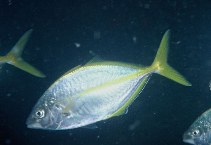| Family: |
Carangidae (Jacks and pompanos), subfamily: Caranginae |
| Max. size: |
122 cm TL (male/unsexed); max.weight: 18 kg; max. reported age: 49 years |
| Environment: |
reef-associated; brackish; marine; depth range 10 - 238 m |
| Distribution: |
Western Atlantic: North Carolina, USA and Bermuda to southern Brazil. Eastern Atlantic: Mediterranean, Azores, Madeira, the Canary Islands, Cape Verde, Ascension and St. Helena Island. Indo-Pacific: South Africa, Japan, Hawaii (Ref. 26145), Australia, Lord Howe and Norfolk islands, New Zealand. Reported from New Caledonia (Ref. 9070). |
| Diagnosis: |
Dorsal spines (total): 9-9; Dorsal soft rays (total): 25-26; Anal spines: 3-3; Anal soft rays: 21-22; Vertebrae: 25-25. Greenish blue above, silvery white below; midside of body with yellow stripe; opercle with black spot (Ref. 3197). LL with 20-26 scutes (Ref. 6390). With maxilla the rear edge sloping slightly forward to its main axis, a large, diffuse dark blotch on the operculum, and a lateral line with 57-78 scales in the curved portion and 34-46 posterior scutes (Ref. 33616). |
| Biology: |
Adults occur in bays and coastal waters, including estuaries (Ref. 9563). Juveniles usually inhabit estuaries, bays and shallow continental shelf waters, while adults form schools near the sea bed on the continental shelf (Ref. 6390). Schools are found at the surface, in mid-water and on the bottom and are often associated with reefs and rough bottom (Ref. 9072). Schools are sometimes mixed with Caranx koheru and Arripis trutta (Ref. 9072). Feed on plankton by ram-filtering and suction feeding and on bottom invertebrates (Ref. 9072, 30206). Eggs are pelagic (Ref. 4233). Cultured only in Japan. (Ref. 4931). One of the best table fish 'being indeed the salmon of St. Helena' (Ref. 5288). |
| IUCN Red List Status: |
Least Concern (LC); Date assessed: 10 May 2013 Ref. (130435)
|
| Threat to humans: |
harmless |
Source and more info: www.fishbase.org. For personal, classroom, and other internal use only. Not for publication.

